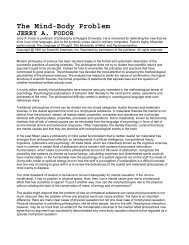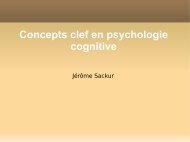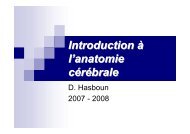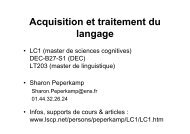From single to multiple deficit models of developmental disorders
From single to multiple deficit models of developmental disorders
From single to multiple deficit models of developmental disorders
Create successful ePaper yourself
Turn your PDF publications into a flip-book with our unique Google optimized e-Paper software.
392 B.F. Penning<strong>to</strong>n / Cognition 101 (2006) 385–413<br />
3.1.4. Cognitive overlap<br />
In the Willcutt et al. (2001) study which used a 2 £ 2 design, we found that the cognitive<br />
phenotype in children with both RD and ADHD was essentially the sum <strong>of</strong> the<br />
phenotype in each disorder considered separately. Once full scale IQ and subclinical<br />
elevations <strong>of</strong> RD or ADHD were controlled statistically, we found main eVects <strong>of</strong><br />
ADHD on measures <strong>of</strong> inhibition (S<strong>to</strong>p Task and Continuous Performance Test)<br />
and main eVects <strong>of</strong> RD on measures <strong>of</strong> phoneme awareness (PA) and verbal working<br />
memory (WM), but no signiWcant interactions. The one caveat is that there was a<br />
trend for an RD main eVect on inhibition measures, indicating that the double dissociation<br />
between RD and ADHD was not <strong>to</strong>tally clean. So the etiology <strong>of</strong> isolated<br />
ADHD presumably led <strong>to</strong> an inhibition deWcit but did not aVect the cognitive markers<br />
<strong>of</strong> RD: PA and verbal WM. In contrast, the etiology <strong>of</strong> isolated RD did have<br />
some marginal eVects on inhibition, which is the cognitive marker for ADHD. This<br />
asymmetric pattern would be consistent with the pleiotropy hypothesis. That is, the<br />
RD risk locus on 6p aVects two largely separate cognitive processes, phonological<br />
processing and inhibition, and individuals with this risk locus are more likely <strong>to</strong> have<br />
deWcits on both, thus explaining the comorbidity between RD and ADHD.<br />
However, this cognitive pleiotropy hypothesis is less parsimonious than one in<br />
which shared etiologic risk fac<strong>to</strong>rs lead <strong>to</strong> shared cognitive risk fac<strong>to</strong>rs because the<br />
cognitive pleiotropy hypothesis must explain why the shared etiological risk fac<strong>to</strong>r<br />
leads <strong>to</strong> both cognitive deWcits in some individuals and not others. So perhaps by<br />
examining other cognitive deWcits, we might Wnd more evidence for a cognitive overlap<br />
between RD and ADHD.<br />
In a new sample <strong>of</strong> subjects also using a 2 £ 2 design, and now including measures<br />
<strong>of</strong> processing speed, we found more evidence for cognitive overlap between RD and<br />
ADHD (Willcutt, Penning<strong>to</strong>n, Olson, Chhabildas, & Hulslander, 2005). The RD<br />
only, ADHD only, and RD + ADHD groups had deWcits <strong>of</strong> similar magnitude on the<br />
processing speed fac<strong>to</strong>r. So a deWcit in processing speed might be a cognitive risk fac<strong>to</strong>r<br />
that is shared by RD and ADHD.<br />
The processing speed measures in this study included the Wechsler Coding and<br />
Symbol Search subtests, and the color and word naming baseline conditions <strong>of</strong> the<br />
Stroop. So they included both linguistic and non-linguistic measures <strong>of</strong> processing<br />
speed. Because rapid serial naming (RSN) tasks can also be thought <strong>of</strong> as measuring<br />
processing speed, we included them in a follow-up study (Shanahan et al., in press). A<br />
fac<strong>to</strong>r analysis <strong>of</strong> various processing speed measures found two fac<strong>to</strong>rs: a verbal fac<strong>to</strong>r<br />
(on which RSN and the Stroop baseline conditions loaded) and a mo<strong>to</strong>r fac<strong>to</strong>r<br />
(on which Wechsler Symbol Search and Coding loaded). Again using a 2 £ 2 design,<br />
we found main eVects <strong>of</strong> both ADHD and RD status on both fac<strong>to</strong>rs. There was also<br />
an ADHD x RD interaction, such that the comorbid group was less impaired on<br />
each fac<strong>to</strong>r than the sum <strong>of</strong> the deWcits found in each pure group. Given these results,<br />
we reasoned that RD and ADHD were not cognitively independent in the domain <strong>of</strong><br />
processing speed. So in this study we did Wnd evidence for a cognitive risk fac<strong>to</strong>r that<br />
is shared by RD and ADHD.<br />
In sum, our cognitive studies <strong>of</strong> the heterotypic comorbidity between RD and<br />
ADHD have found both cognitive deWcits speciWc <strong>to</strong> each disorder (in phonological







